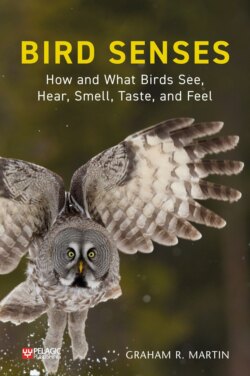Читать книгу Bird Senses - Graham R. Martin - Страница 49
На сайте Литреса книга снята с продажи.
Colour vision
ОглавлениеAs noted in the ‘What eyes do‘ section above, the prime function of colour vision is that it allows the extraction of spatial detail by using differences in the wavelengths of light that make up the image. It seems unlikely that colour vision evolved specifically for enhancing information about the presence and properties of certain types of objects that are key in the life of an animal. It is more likely that it first evolved to meet a broad range of spatial tasks.
Examples of situations where detection is enhanced by colour vision in birds include the use of objects in display behaviours (as seen, for example, among bowerbirds (Ptilonorhynchidae, order Passeriformes)), and the detection of plumage patterns and particular flowers or fruits against foliage backgrounds. This does not mean, however, that these specific tasks were the prime drivers for the evolution of colour vision. Indeed, it seems more likely that the colour of plumages, flowers or fruits evolved to become more conspicuous in response to the vision of the observing birds, rather than that the vision of the birds evolved to detect these particular objects.
Fruits that are eaten regularly by birds have probably evolved to encourage their detectability. This is because consumption of the fruit will result in wider dispersal of seeds. Thus, many fruits have evolved to be detected by birds and this is achieved in two ways. First, the ripe fruits (ready for seed dispersal) reflect light that contrasts with the surrounding foliage, both in brightness and in colour. Second, smaller fruits often occur in conspicuous concentrations, so that they present a larger target that can be detected with relatively low-resolution vision at a distance.
Figure 3.6 shows some examples of fruits whose seed dispersal is aided by birds. It is clear that they reflect light from different parts of the spectrum, from the red and orange wavelengths to the blues and ultraviolets. Interestingly, the same bird species may consume fruits with all of these different colours, suggesting that there are no specialisations of vision associated with detecting fruits of particular colours. For example, European Robins are known to consume all of the fruits shown in Figure 3.6, plus many more.
FIGURE 3.6 Fruits that are commonly eaten by birds in the British Isles, all of which have been recorded in the diets of European Robins Erithacus rubecula. Top row, left to right: Common Buckthorn Rhamnus cathartica, Elder Sambucus nigra. Middle row: Blackthorn (Sloe) Prunus spinosa, Common Juniper Juniperus communis, Spindle Euonymus europaeus. Bottom row: Hawthorn Crataegus monogyna, Rowan Sorbus aucuparia.
All of these fruits occur in large concentrations, creating a large target for the bird to detect. This suggests that their detection does not require vision of high spatial resolution. As Figure 3.6 shows, although the individual fruits tend to be relatively small, they usually occur in large clusters. Therefore, the initial task for a bird is to detect these clusters at a long distance. Once it has found a cluster it is more or less guaranteed access to a large food source. Individual fruits can be detected when the birds work over the tree or shrub, but they can find this food source at a distance because of the large aggregations of individual fruits.
The ability to detect colour differences within the spectrum has not been determined directly in many bird species. Although colour might seem conspicuous, it is surprisingly difficult to show definitively that an animal is using colour vision. This is because surfaces may be discriminated both by colour and by brightness at the same time. To sort between these possibilities requires careful, and typically laborious, behavioural experiments. The most detailed knowledge available is from behavioural and electrophysiological studies in Rock Doves (Feral Pigeons) Columba livia. It is, however, possible to say something about colour vision, and the breadth of the spectrum visible, in birds in general.
This is based on knowledge of the visual sensitivity of individual cone receptors, and it seems safe to assume that practically all birds have colour vision. Furthermore, the ability to differentiate colours in much of the spectrum differs little between species. Even the nocturnally active owls are thought to have some colour vision, although it is not as sophisticated or as subtle as that of other bird species. However, genome analysis, although not the determination of visual pigments directly, suggests that colour vision may be absent from the kiwi species, and these may be the only group of birds that are not capable of making colour discriminations.
